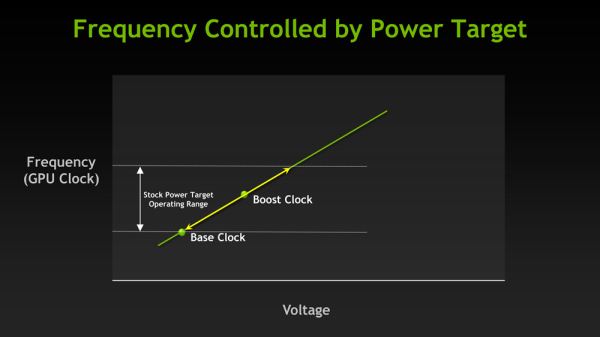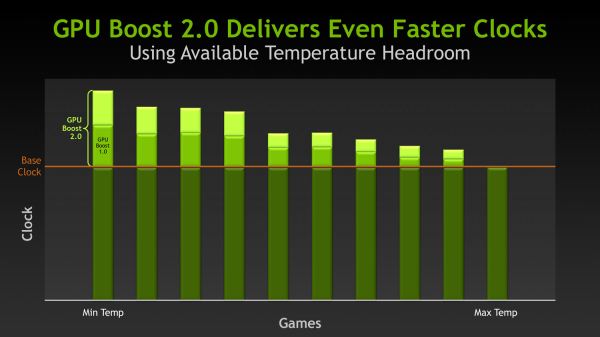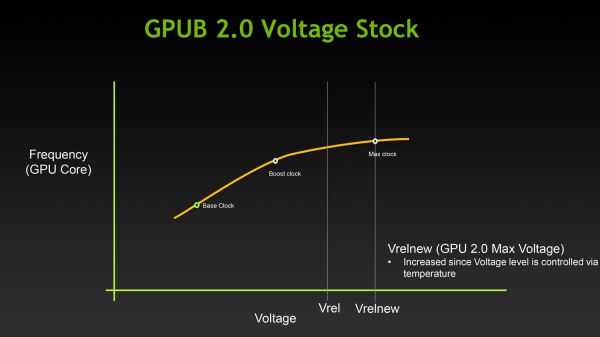NVIDIA's GeForce GTX Titan, Part 1: Titan For Gaming, Titan For Compute
by Ryan Smith on February 19, 2013 9:01 AM ESTGPU Boost 2.0: Temperature Based Boosting
With the Kepler family NVIDIA introduced their GPU Boost functionality. Present on the desktop GTX 660 and above, boost allows NVIDIA’s GPUs to turbo up to frequencies above their base clock so long as there is sufficient power headroom to operate at those higher clockspeeds and the voltages they require. Boost, like turbo and other implementations, is essentially a form of performance min-maxing, allowing GPUs to offer higher clockspeeds for lighter workloads while still staying within their absolute TDP limits.
With the first iteration of GPU Boost, GPU Boost was based almost entirely around power considerations. With the exception of an automatic 1 bin (13MHz) step down in high temperatures to compensate for increased power consumption, whether GPU Boost could boost and by how much depended on how much power headroom was available. So long as there was headroom, GPU Boost could boost up to its maximum boost bin and voltage.
For Titan, GPU Boost has undergone a small but important change that has significant ramifications to how GPU Boost works, and how much it boosts by. And that change is that with GPU Boost 2, NVIDIA has essentially moved on from a power-based boost system to a temperature-based boost system. Or perhaps more precisely, a system that is predominantly temperature based but is also capable of taking power into account.
When it came to GPU Boost 1, its greatest weakness as explained by NVIDIA is that it essentially made conservative assumptions about temperatures and the interplay between high temperatures and high voltages in order keep from seriously impacting silicon longevity. The end result being that NVIDIA was picking boost bin voltages based on the worst case temperatures, which meant those conservative assumptions about temperatures translated into conservative voltages.
So how does a temperature based system fix this? By better mapping the relationship between voltage, temperature, and reliability, NVIDIA can allow for higher voltages – and hence higher clockspeeds – by being able to finely control which boost bin is hit based on temperature. As temperatures start ramping up, NVIDIA can ramp down the boost bins until an equilibrium is reached.
Of course total power consumption is still a technical concern here, though much less so. Technically NVIDIA is watching both the temperature and the power consumption and clamping down when either is hit. But since GPU Boost 2 does away with the concept of separate power targets – sticking solely with the TDP instead – in the design of Titan there’s quite a bit more room for boosting thanks to the fact that it can keep on boosting right up until the point it hits the 250W TDP limit. Our Titan sample can boost its clockspeed by up to 19% (837MHz to 992MHz), whereas our GTX 680 sample could only boost by 10% (1006MHz to 1110MHz).
Ultimately however whether GPU Boost 2 is power sensitive is actually a control panel setting, meaning that power sensitivity can be disabled. By default GPU Boost will monitor both temperature and power, but 3rd party overclocking utilities such as EVGA Precision X can prioritize temperature over power, at which point GPU Boost 2 can actually ignore TDP to a certain extent to focus on power. So if nothing else there’s quite a bit more flexibility with GPU Boost 2 than there was with GPU Boost 1.
Unfortunately because GPU Boost 2 is only implemented in Titan it’s hard to evaluate just how much “better” this is in any quantities sense. We will be able to present specific Titan numbers on Thursday, but other than saying that our Titan maxed out at 992MHz at its highest boost bin of 1.162v, we can’t directly compare it to how the GTX 680 handled things.













157 Comments
View All Comments
vacaloca - Tuesday, February 19, 2013 - link
A while ago when K20 released and my advisor didn't want to foot the bill, I ended up doing it myself. Looks like the K20 might be going to eBay since I don't need HyperQ MPI and GPU Direct RDMA or ECC for that matter. I do suspect that it might be possible to crossflash this card with a K20 or K20X BIOS and mod the softstraps to enable the missing features... but probably the video outputs would be useless (and warranty void, and etc) so it's not really an exercise worth doing.Props to NVIDIA for releasing this for us compute-focused people and thanks to AnandTech for the disclosure on FP64 enabling. :)
extide - Tuesday, February 19, 2013 - link
Can you please run some F@H benchmarks on this card? I would be very very interested to see how well it folds. Also if you could provide some power consumption numbers (watts @ system idle and watts when gpu only is folding).That would be great :)
Thanks!
Ryan Smith - Tuesday, February 19, 2013 - link
OpenCL is broken with the current press drivers. So I won't have any more information until NVIDIA issues new drivers.jimhans1 - Tuesday, February 19, 2013 - link
Alright, the whining about this being a $1000 card is just stupid; nVidia has priced this right in my eyes on the performance/noise/temperature front, they have never billed this as being anything other than an Extreme style GPU, just like the 690, yes the 690 will outperform this in raw usage, but not by much I'm guessing, and it will run hotter, louder and use more power than the Titan, not to mention possible SLI issues that have plagued ALL SLI/CF on one PCB cards to date. If you want THE high end MAINSTREAM card, you get the 680, if you wan't the EXTREME card(s), you get the Titan or 690.Folks, we don't yell at Ferrari or Bugatti for pricing their vehicles to their performance capabilities; nobody yelled at Powercolor for pricing the Devil 13 at $1000 even though the 690 spanks it on ALMOST all fronts for $100 LESS.
Yes, I wish I could afford 1 or 3 of the Titans; but' I am not going to yell and whine about the $1000 price because I CAN'T afford them, it gives me a goal to try and save my sheckles to get at least 2 of them before years end, hopefully the price may (but probably won't) have dropped by then.
chizow - Tuesday, February 19, 2013 - link
The problem with your car analogy is that Nvidia is now charging you Bugatti prices for the same BMW series you bought 2 years ago. Maybe an M3 level of trim this time around, but it's the same class of car, just 2x the price.Sandcat - Wednesday, February 20, 2013 - link
The high end 28nm cards have all been exercises in gouging. At least they're being consistent with the 'f*ck the customer because we have a duopoly' theme.Kevin G - Tuesday, February 19, 2013 - link
The card is indeed a luxury product. Like all consumer cards, this is crippled in in some way compared to the Quadro and Tesla lines. Not castrating FP64 performance is big. I guess nVidia finally realized that the HPC market values reliability more than raw computer and hence why EDC/ECC is disabled. ditto for RMDA, though I strongly suspect that RMDA is still used for SLI between Geforce cards - just a lock out to another vendor's hardware.The disabling of GPU Boost for FP64 workloads is odd. Naturally it should consumer a bit more energy to do FP64 workloads which would either result in higher temps at the same frequency as FP32 or lower clocks at the same frequency as FP32. The surprise is that users are don't have the flexibility to choose or adjust those settings.
Display overclocking has me wondering exactly what is being altered. DVI and DP operate at distinct frequencies and moving to a higher refresh rate at higher resolutions should also increase this. Cable quality would potentially have an impact here as well. Though for lower resolutions, driving them at a higher refresh rate should still be within the cabling spec.
Kepe - Tuesday, February 19, 2013 - link
The comment section is filled with NVIDIA hate, on how they dropped the ball, lost their heads, smoked too much and so on. What you don't seem to understand is that this is not a mainstream product. It's not meant for those who look at performance/$ charts when buying their graphics cards. This thing is meant for those who have too much money on their hands. Not the average Joe building his next gaming rig. And as such, this is a valid product at a valid price point. A bit like the X-series Intel processors. If you look at the performance compared to their more regular products the 1000+ dollar price is completely ridiculous.You could also compare the GTX Titan to a luxury phone. They use extravagant building materials, charge a lot of extra for the design and "bling", but raw performance isn't on the level of what you'd expect by just looking at the price tag.
jimhans1 - Tuesday, February 19, 2013 - link
I agree, the pricing is in line with the EXPECTED user base for the card; it is NOT a mainstream card.Sandcat - Tuesday, February 19, 2013 - link
The disconnect regards the Gx110 chip. Sure, it's a non-mainstream card, however people do have the impression that it is the lock-step successor to the 580, and as such should be priced similarly.Nvidia does need to be careful here, they enjoy a duopoly in the market but goodwill is hard to create and maintain. I've been waiting for the 'real' successor to the 580 to replace my xfire 5850's and wasn't impressed with the performance increase of the 680. Looks like it'll be another year....at least.
:(